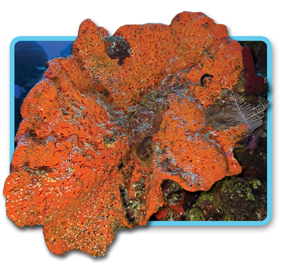Porifera (Sponges)

KEY CHARACTERISTICS
Sponges are the simplest animals. They are classified as animals because they are multicellular, heterotrophic, lack cell walls, and have some specialized cells. They are aquatic, lack true tissues and organs, and have internal skeletons of spongin and/or spicules of calcium carbonate or silica. Sponges have no body symmetry.
Feeding and Digestion Filter feeders; intracellular digestion.
Circulation Via flow of water through body
Respiration Oxygen diffuses from water into cells as water flows through body.
Excretion Wastes diffuse from cells into water as water flows through body.
Response No nervous system; little capacity to respond to environmental changes.
Movement Juveniles drift or swim freely; adults are stationary.
Reproduction Most—sexual with internal fertilization; water flowing out of sponge disperses sperm, which fertilizes eggs inside sponge(s); may reproduce asexually by budding or producing gemmules.
There are more than 5000 species of sponges; most are marine. Three major groups are described below.
DEMOSPONGIAE: Typical sponges
More than 90 percent of all living sponge species are in this group, including the few freshwater species. They have skeletons made of spongin, a flexible protein. Some species have silica spicules. Examples: Yellow Sponge, bath sponges, Carnivorous Mediterranean Sponge, tube sponges

Orange Elephant Ear Sponge
HEXACTINELLIDA: Glass sponges
Glass sponges live in the deep ocean and are especially abundant in the Antarctic. They are called “glass” sponges because their skeletons are made of glasslike silica spicules. Examples: Venus's Flower Basket, Cloud Sponge

Glass Sponge
CALCAREA: Calcareous sponges
Calcareous sponges live in shallow, tropical marine waters and are the only sponges with calcium carbonate spicules. Example: Clathrina

Yellow Tubular Sponge
Table of Contents
- Formulas and Equations
- Applying Formulas and Equations
- Mean, Median, and Mode
- Estimation
- Using Measurements in Calculations
- Effects of Measurement Errors
- Accuracy
- Precision
- Comparing Accuracy and Precision
- Significant Figures
- Calculating With Significant Figures
- Scientific Notation
- Calculating With Scientific Notation
- Dimensional Analysis
- Applying Dimensional Analysis




